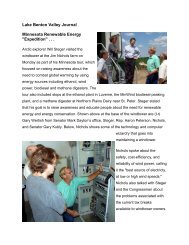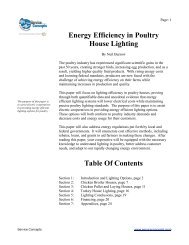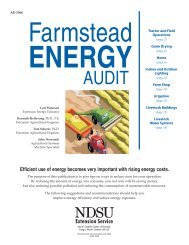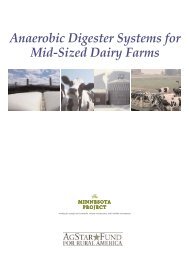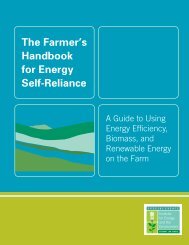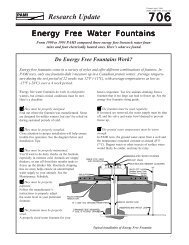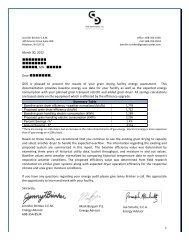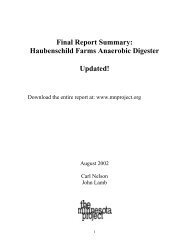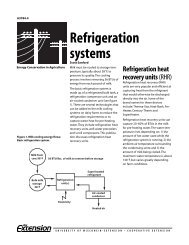Dairy Farm Energy Management Handbook - Wisconsin Department ...
Dairy Farm Energy Management Handbook - Wisconsin Department ...
Dairy Farm Energy Management Handbook - Wisconsin Department ...
Create successful ePaper yourself
Turn your PDF publications into a flip-book with our unique Google optimized e-Paper software.
But since each dairy farm may face different circumstances, it is very<br />
important to start with an energy audit that can help provide a snapshot view<br />
of your current situation.<br />
The farm energy audit will serve as a meaningful reference point upon which<br />
better decisions and comparisons can be made about equipment upgrades<br />
and wiring issues and what changes may offer the quickest paybacks.<br />
Such paybacks will obviously occur more quickly in those key areas that<br />
normally use the most energy on your dairy farm.<br />
On most dairy farms in <strong>Wisconsin</strong>, milk cooling<br />
accounts for the lion’s share of electricity usage at<br />
25%, followed by ventilation at 19%, water heating<br />
at 18%, vacuum pumps at 17%, and lighting at<br />
15%. Electric space heating and miscellaneous<br />
uses accounted for another 6% of electricity usage.<br />
(2)<br />
<strong>Dairy</strong> farms in other states also show similar energy<br />
demands. For example, according to the <strong>Dairy</strong><br />
<strong>Farm</strong> <strong>Energy</strong> Audit Summary in New York, milk<br />
cooling, lighting, ventilation, and vacuum pumps<br />
are the top four categories that accounted for 88% of all electrical energy<br />
used on all of the audited farms.<br />
Breaking this down further, milk cooling’s share totaled 25%, followed by<br />
lighting at 24%, ventilation at 22%, and vacuum pumps at 17%. Electric water<br />
heating (4%), manure handling (4%), feeding equipment (3%), and<br />
miscellaneous (1%) made up the balance of 12%.<br />
So, an energy audit is well worth the effort since experience has already<br />
shown that dairy producers can save 10 to 40% – or more, in some cases –<br />
by using reliable energy-efficient technology in their milking, milk cooling, and<br />
water heating processes, according to the University of <strong>Wisconsin</strong> - Madison.<br />
“Getting an energy audit done on your farm is an important first step to take<br />
in developing a comprehensive energy management plan,” says Scott<br />
Sanford, senior outreach specialist with the University of <strong>Wisconsin</strong>’s Rural<br />
<strong>Energy</strong> Program.




